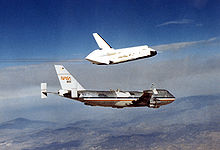Charles Gordon Fullerton
| Gordon Fullerton | |
|---|---|

|
|
| Country: | United States |
| Organization: | NASA |
| selected on | June 30, 1966 ( 2nd MOL group ) August 14, 1969 (7th NASA group) |
| Calls: | 2 space flights |
| Start of the first space flight: |
March 22, 1982 |
| Landing of the last space flight: |
August 6, 1985 |
| Time in space: | 15d 22h 50m |
| retired on | October 1986 |
| Space flights | |
Charles Gordon Fullerton (born October 11, 1936 in Rochester , New York , † August 21, 2013 in Lancaster , California ) was an American astronaut .
Fullerton attended US Grant High School in Portland , Oregon . In 1957 he received a bachelor's degree and a master's degree in mechanical engineering from the California Institute of Technology in 1958 . In July 1958 Fullerton entered the United States Air Force one, after serving as a design engineer for Hughes Aircraft in Culver City ( California had worked). After completing his pilot training, he flew the F-86 , and later became a B-47 bomber pilot at Davis-Monthan Air Force Base , Arizona. In 1964 he was trained as a test pilot at Edwards Air Force Base and then worked as such at Wright-Patterson Air Force Base in Ohio .
Astronaut activity
Fullerton applied to be an astronaut with both NASA and the Air Force and was selected by the Air Force for the Manned Orbiting Laboratory (MOL) program on June 30, 1966 . He was intended to crew the military space station until the program was halted in 1969 and he was taken over by NASA.
Fullerton became a member of the support teams for the Apollo 14 , 15 , 16 and 17 lunar missions . After the end of the lunar program in 1972, Fullerton switched to the space shuttle program and worked on the cockpit design. In 1977 Fullerton became a test pilot for the space shuttle prototype Enterprise and carried out approach and landing tests together with Fred Haise .
On March 22, 1982, Fullerton started as a pilot of the Columbia space shuttle under the command of Jack Lousma on its first mission into space . During the eight-day STS-3 mission, the Columbia was tested for its thermal resistance on its third test flight. The shuttle's robotic arm was also tested. The landing took place on March 30, 1982 for the first and only time in White Sands , New Mexico .
On July 29, 1985, Fullerton took off as commander of the space shuttle Challenger for the Spacelab-2 mission ( STS-51-F ). It was the first flight of the European space laboratory without a pressure module - the experiments (mainly in the disciplines of astronomy and astrophysics) were installed on three pallets in the Challenger's hold. The crew worked in two shifts in order to achieve the maximum possible utilization of the experiments.
After his space flights, Fullerton was still a research pilot at NASA's Dryden Flight Research Center and at Edwards Air Force Base. Then he was a project pilot for the Propulsion Controlled Aircraft program and was involved in the launches of the Pegasus rocket . Fullerton left NASA on December 31, 2007 and retired.
The Cygnus Orb-1 space transporter, launched on January 9, 2014, was named after him.
Private
His marriage had two children.
See also
Web links
- Short biography of Charles Gordon Fullerton at spacefacts.de
- NASA biography of Charles Gordon Fullerton (English; PDF)
- Biography of Charles Gordon Fullerton in the Encyclopedia Astronautica (English)
- Transcript of a NASA interview from May 2002 in the JSC Oral History Project (English)
| personal data | |
|---|---|
| SURNAME | Fullerton, Charles Gordon |
| BRIEF DESCRIPTION | American astronaut |
| DATE OF BIRTH | October 11, 1936 |
| PLACE OF BIRTH | Rochester , New York |
| DATE OF DEATH | August 21st, 2013 |
| Place of death | Lancaster |
